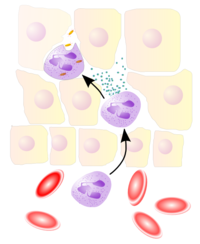Diapedesis
The diapedesis (from the Greek diapedan, to go through) is the passage of formed elements of the blood (such as leukocytes), through the blood capillaries to go to the focus of inflammation or infection without capillary damage.
Biochemical aspects
All white blood cells (leukocytes) have this property, since they need to pass through the walls of blood vessels to access tissues and organs. This extravascular migration occurs through successive steps, which are: rolling, signaling, firm adhesion, and diapedesis.
This process is carried out in the blood capillaries and in the venules, and is produced by a contraction of the endothelium of the vessels).
Substances that induce diapedesis are:
- Histamine, TNF, INF: produce contraction of endothelial cells;
- Selectine P, ICAM, NCAM: are endothelium molecules that allow the union of leucocytes;
- Sialil Lewis X, integrains: they are molecules of leucocytes that allow the connection to the endothelium.
Leukocytes have collagenase that breaks the dense basement membrane of the capillary and reach the inflammatory focus, attracted by molecules called chemokines (such as C3A).
Contenido relacionado
Fucoxanthin
Karl Landsteiner
Stenohaline
